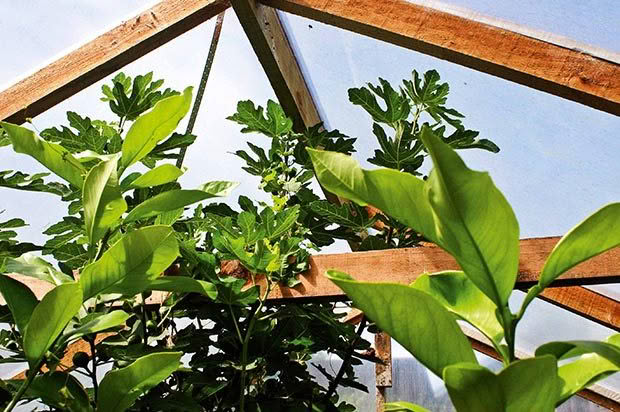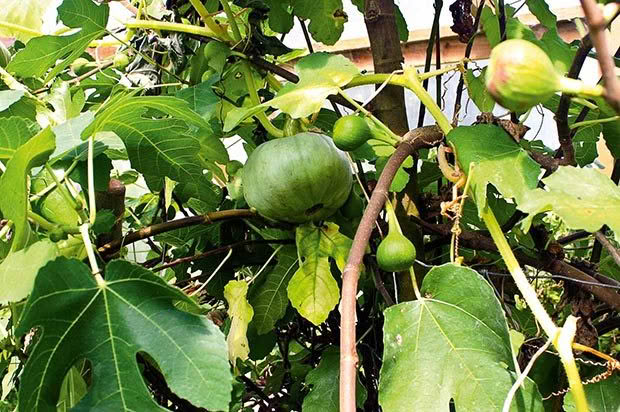Does orchard size matter?

A fig and a pomelo in Gary’s tunnel house.
Ben Gaia visits two small sections that are big on production.
Words: Ben Gaia
It’s amazing what a variety of food-producing trees and plants you can squeeze into a carefully managed small area. Both these orchards use plastic tunnel houses to boost production. These are effective in all but the windiest areas (where they blow to pieces) and so glasshouses or walled gardens should be tried instead.
AN ORCHARD ON HALF A SECTION
Size: 500m²
Graeme and Krissy’s orchard is a classic lifestyle block garden, with raised beds of veges and herbs, two currant beds, and small fruit trees as centrepieces through the garden. The productive tunnel house pumps out tomatoes and winter veges, sheltered from the weather. It also provides the backdrop for the ripening grapes which need to be sheltered and in a suntrap. The grape vine is along the north wall of the tunnel house.
Part of the charm of Graeme and Krissy’s place is the native bush surround. Along the drive, sheltered by remnant rimu stands, survives a range of optimistic citrus, waiting for that killer frost from Otago. So far though, they are thriving with lots of TLC.
The garden supplants the front lawn and is all visible from the house windows. Paths and in-between areas are flat, solid packed gravel, but river stone patios could be added to absorb heat. It all fits in a postage stamp-size area – the garden hose reaches everything from the house tap.
There are cherry trees for colour, well-pruned plum trees and feijoa bushes, a NZ cranberry bed, and a vege garden that’s highly-productive all year round.
Graeme has taken his farming expertise and produced a bonsai-sized permaculture orchard: neat, trim, and above all manageable, demonstrating how you can have a highly-productive orchard garden on the space of half a section.
RIPE FIGS EVERY TIME
Size: approx. 60m²
Gary’s tunnel house is a miniature food jungle in a 10m by 6m format. It is a tall house-shaped frame of pine and rimu covered with stretched agphane greenhouse film and it’s very warm. When you close a tunnel house in it becomes a tropical house, and Gary’s pomeloes, figs, tomatoes and basil testify to that. He also grows lettuce, coriander, parsley, chives, and other veges throughout the year for his signature Mexican dishes.

Pumpkins winding their way up the fig tree.
In early autumn, the tomato plants are overflowing and a pumpkin vine has sprawled up the central fig tree, happily fruiting at eye level. There are Jerusalem artichokes, a tamarillo, and a black passionfruit, all thriving in the almost-excessive heat and high humidity of this home-made micro climate. The key is generous watering with a hand-held hose, ensuring the survival of plants that would otherwise be cooked.
The fig and pomeloes are nearly touching the 3m high roof already so Gary is in for some heavy pruning.
The fig is espaliered on sheep netting and twisted around itself to create a natural lattice structure. This year there are big blue figs dripping off the bush and tasting as sweet as any in a European backyard. Brown Turkey figs certainly appreciate this extra climatic boost, and makes my own cardboardy, outdoor figs seem feeble.
The pomelo is a huge Asian grapefruit shaped like a soccer ball, which tastes as sweet as syrup when ripe. Filipino Kiwis will know it well. Pomeloes are a tropical citrus and seem to grow well in a tunnel house, but would not like any outdoor frost or wind exposure. Black passionfruit love a tunnel house and will take it over completely if not kept disciplined. For colour, Gary has sensitive plants and sage, plus experiments with mosses and ferns adorning sunken pathways.
About the author
Ben Gaia grows trees in the extreme climate of the West Coast of the South Island and runs a mail order nursery for organic fruit and forestry trees, www.dialatree.co.nz
Love this story? Subscribe now!
 This article first appeared in NZ Lifestyle Block Magazine.
This article first appeared in NZ Lifestyle Block Magazine.
